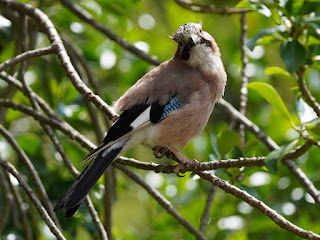The Great Tits in the Flower Walk are looking very worn after raising their young.
So is the familiar female Coal Tit. But they were all coming down enthusiastically to take pine nuts from my hand.
A flock of Long-Tailed Tits passed over the tops of the holly trees. This one doesn't have a very long tail, but all the small birds are looking tatty at the moment. They will regrow their feathers in the autumn.
This Chaffinch at the leaf yard is a familiar sight, but dreadfully hard to photograph. He absolutely refuses to pose nicely for his picture.
A Jay was angling for a peanut.
A finely multicoloured pigeon perched on the bulbous base of a cork oak.
A pair fondled each other on a post at Peter Pan. As so often, they had gone for a mate exactly the same colour as themselves.
A Little owlet looked down from the tree near the Serpentine Gallery.
Here is its mother on the next tree.
The male at the Round Pond was on a favourite branch which gives him a good view.
Another excellent picture by Cindy Chen of him in flight.
The young Grey Herons at the west end of the island are beginning to be quite easily visible, but they haven't yet go to the stage where they leave the nest and climb around in the branches.
A young Coot tried to help its parent add willow twigs to the nest at the bridge, but had little idea of how to do it.
The Coot nesting on the old water filter under the Italian Garden still only has one egg to replace the two it lost. It seems to have finally run out of steam, which is unusual for one of these tireless birds.
A young Egyptian Goose displayed fully developed wing feathers, but it will be a while before it starts running around trying to fly.
Blondie has regrown her flight feathers. She can probably fly now, but is the most sedentary creature imaginable. As usual she was only a few yards from the place where she was hatched at the east end of the Serpentine.
Most of the white butterflies in the park are Small or Green-Veined. Conehead 54 tells me that this is a female Green-Veined White, but it looks far from typical with very large dark spots and an unusually pale abdomen.









%202022%202a.jpg)





Do parents teach their offspring to build nests? It looks as if it is an innate drive, but on the other hand the chick appears to be learning by imitation.
ReplyDeleteTinúviel
Both, I think: the drive is innate but the method has to be learnt.
DeleteThat's a female Green-veined White, Ralph, Large doesn't show those dark triangles on the vein ends.
ReplyDeleteOK, I suppose there's a good deal of variation. But that butterfly has remarkably large and well marked dark spots and a very pale abdomen for a GVW.
Delete